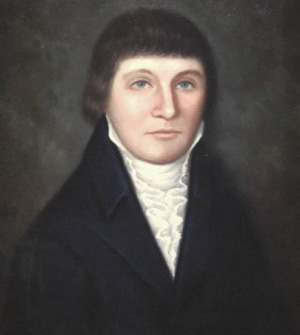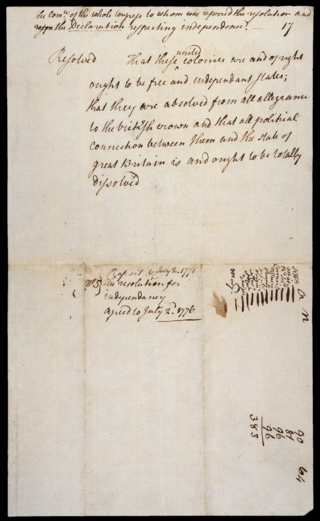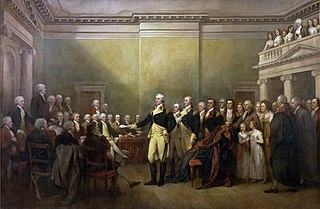
The Declaration of Independence, formally titled The unanimous Declaration of the thirteen united States of America, is the founding document of the United States. On July 4, 1776, it was adopted unanimously by the 56 delegates to the Second Continental Congress, who had convened at the Pennsylvania State House, later renamed Independence Hall, in the colonial era capital of Philadelphia. The declaration explains to the world why the Thirteen Colonies regarded themselves as independent sovereign states no longer subject to British colonial rule.

Timeline of the American Revolution—timeline of the political upheaval culminating in the 18th century in which Thirteen Colonies in North America joined together for independence from the British Empire, and after victory in the Revolutionary War combined to form the United States of America. The American Revolution includes political, social, and military aspects. The revolutionary era is generally considered to have begun with the passage of the Stamp Act in 1765 and ended with the ratification of the United States Bill of Rights in 1791. The military phase of the revolution, the American Revolutionary War, lasted from 1775 to 1783.
Francis Nash was a brigadier general in the Continental Army during the American Revolutionary War. Prior to the war, he was a lawyer, public official, and politician in Hillsborough, North Carolina, and was heavily involved in opposing the Regulator movement, an uprising of settlers in the North Carolina piedmont between 1765 and 1771. Nash was also involved in North Carolina politics, representing Hillsborough on several occasions in the colonial North Carolina General Assembly.

Richard Caswell was an American politician and lawyer who served as the first and fifth governor of the U.S. state of North Carolina from 1776 to 1780 and from 1785 to 1787. He also served as a senior officer of militia in the Southern theater of the American Revolutionary War. As a delegate to the First Continental Congress, he was a signatory of the 1774 Continental Association.

The Lee Resolution, also known as "The Resolution for Independence", was the formal assertion passed by the Second Continental Congress on July 2, 1776, which resolved that the Thirteen Colonies, then referred to as the United Colonies, were "free and independent States" and separate from the British Empire, which created what became the United States. News of this act was published that evening in The Pennsylvania Evening Post and the next day in The Pennsylvania Gazette. The Declaration of Independence, which officially announced and explained the case for independence, was approved two days later, on July 4, 1776.

The Connecticut Line was a formation within the Continental Army. The term "Connecticut Line" referred to the quota of numbered infantry regiments assigned to Connecticut at various times by the Continental Congress, the size of its allocation determined by the size of its population relative to that of other states. These, together with similarly apportioned contingents from the other twelve states, formed the Continental Line. The concept was particularly important in relation to the promotion of commissioned officers. Officers of the Continental Army below the rank of brigadier general were ordinarily ineligible for promotion except in the line of their own state.

The New Hampshire Line was a formation in the Continental Army. The term "New Hampshire Line" referred to the quota of numbered infantry regiments assigned to New Hampshire at various times by the Continental Congress. These, along with similar contingents from the other twelve states, formed the Continental Line. For the promotion of senior officials, this concept is particularly important. Officers of the Continental Army below the rank of brigadier general were ordinarily ineligible for promotion except in the line of their own state.

Pennsylvania was the site of many key events associated with the American Revolution and American Revolutionary War. The city of Philadelphia, then capital of the Thirteen Colonies and the largest city in the colonies, was a gathering place for the Founding Fathers who discussed, debated, developed, and ultimately implemented many of the acts, including signing the Declaration of Independence, that inspired and launched the revolution and the quest for independence from the British Empire.
The North Carolina Provincial Congresses were extra-legal unicameral legislative bodies formed in 1774 through 1776 by the people of the Province of North Carolina, independent of the British colonial government. There were five congresses. They met in the towns of New Bern, Hillsborough (3rd), and Halifax. The 4th conference approved the Halifax Resolves, the first resolution of one of Thirteen Colonies to call for independence from Great Britain. Five months later it would empower the state's delegates to the Second Continental Congress to concur to the United States Declaration of Independence. The 5th conference approved the Constitution of North Carolina and elected Richard Caswell as governor of the State of North Carolina. After the 5th conference, the new North Carolina General Assembly met in April 1777.
1776 is celebrated in the United States as the official beginning of the nation, with the Declaration of Independence of the Thirteen Colonies from the British Empire issued on July 4.
Events from the year 1777 in the United States.
Events from the year 1781 in the United States. This year marked the beginning of government under the Articles of Confederation as well as the surrender of British armed forces in the American Revolution.

Then Province of Maryland had been a British / English colony since 1632, when Sir George Calvert, first Baron of Baltimore and Lord Baltimore (1579-1632), received a charter and grant from King Charles I of England and first created a haven for English Roman Catholics in the New World, with his son, Cecilius Calvert (1605-1675), the second Lord Baltimore equipping and sending over the first colonists to the Chesapeake Bay region in March 1634. The first signs of rebellion against the mother country occurred in 1765, when the tax collector Zachariah Hood was injured while landing at the second provincial capital of Annapolis docks, arguably the first violent resistance to British taxation in the colonies. After a decade of bitter argument and internal discord, Maryland declared itself a sovereign state in 1776. The province was one of the Thirteen Colonies of British America to declare independence from Great Britain and joined the others in signing a collective Declaration of Independence that summer in the Second Continental Congress in nearby Philadelphia. Samuel Chase, William Paca, Thomas Stone, and Charles Carroll of Carrollton signed on Maryland's behalf.
This is a list of events in the year 1776 in Delaware.
This is a list of events in the year 1776 in the U.S. state of Georgia.


























